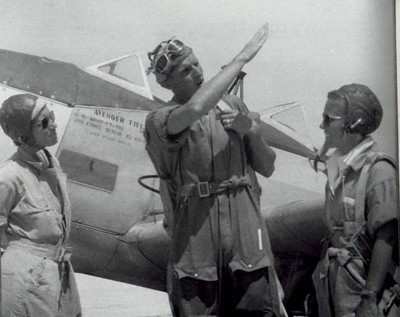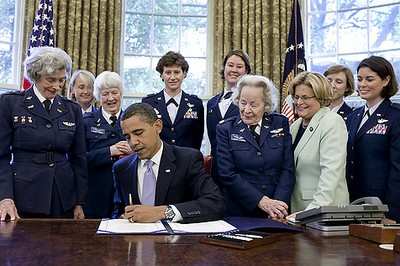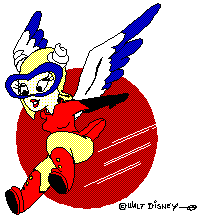Barry Vincent-Smith Became One Of America's First Female
Pilots
It was 1944 and with America in the midst of World War II,
female aviators were being accepted as Women's Airforce Service
Pilots to test aircraft and fly support missions in the U.S.,
freeing up men for combat roles overseas.
Barry Vincent-Smith With Her
Congressional Gold Medal

Barry Vincent-Smith, now 91, began her journey to becoming one
of America's first female pilots in Chittenango, NY, in 1942. Only
22 at the time, she was living with her parents and working at a
telephone company for $25 a week. "My brother George, a pilot who
flew missions over Japan, called and told me women would soon be
accepted as pilots," Barry said. "But, only if they already had at
least 35 hours of flight time under their belts."
Every Friday after work, she took a bus and hitchhiked to a
nearby instructor's school, where she paid $14.50 for weekly flying
lessons. Soon, she had enough hours to apply to the WASP program.
"Between my lessons and a job testing radar over a factory, my dual
and solo hours built up," Barry said. "I called and made an
appointment for an interview. I had never been to a big city
before. I traveled to New York City and was immediately accepted as
a WASP. Others had to wait to hear back if they got in or not."
Out of more than 25,000 women to interview, fewer than 2,000
were accepted. Of those, only 1,074 made it through the training
and earned their wings. "I waited six months to start my training
at Avenger Field in Sweetwater, Texas," Barry said, who reported to
the base in early January 1944. "I was in a class of 137 girls,
including Jackie Cochran. We were busy every day from 6 in the
morning to 10 at night. We spent four hours on the flightline, four
hours at ground school, an hour exercising and an hour marching.
There were meals thrown in there somewhere."
After seven months of that training, she was sent to Blackland
Army Air Force Base in Waco, Texas. After three hours of training
in an A-T6 Texan, she was told she was done with her training.
"They said, 'If you can fly an AT-6, you can fly any fighter the
Air Force has,'" said Barry. "That was exciting. We got to fly
Stearmans and BT-13s (Valiants) and I had a personal AT-10
(Wichita) I got to take out on weekends. We could leave Friday
evening and had to return by midnight on Sunday." She used some of
those weekend trips to visit her brothers who were stationed at
Moody Field, GA, known now as Moody Air Force Base. "I got to fly
in formations with my brothers over Florida on weekends in my
personal plane," Barry said. "Not many people now can say that. It
was a great experience."
USAF WASP File Photo

Barry admits that while some men were surprised to see a woman
in uniform flying, they didn't cause her any problems. "I didn't
have any trouble with the guys and became friends with quite a few
who worked on my planes," she said. "On one training mission where
I was co-piloting, a male pilot climbed in the cockpit, looked at
me and asked where his co-pilot was. I said, 'You're looking at
her. Few people knew that women were flying planes, and even fewer
knew that we were civilians flying military aircraft. We went
through seven months of intense training and wore uniforms, but we
never even had ranks. We were just told to act like officers."
Barry's service as a WASP was cut short after less than a year
when the program was shut down on Dec. 20, 1944. From there, her
life took a different route. After the WASPs disbanded, Barry
headed to her mom's ranch in Sebring, FL., to decide what she
wanted to do with the rest of her life. There, she ran into an old
friend on leave from the Marines -- Les Smith. "Les and I had dated
four times before, but I saw him that time and my goodness, he was
handsome," she said. "He told me he had been writing a girl, Betty,
the years I was gone and that they had a date that night. I
suggested that I come along and he agreed," she said. "I don't
think Betty was too happy to see me, but Les and I drank and smoked
and danced. At a friend's wedding later that weekend, he was the
best man and I was the maid of honor. We had a great time."
But Barry didn't stay a maid for long. A few weeks later, Les
was back in Sebring for 10 days of leave, and as he got in her car
after she picked him up from the bus station, he surprised her.
"Les was reaching down and pulling a shoestring out of his shoe,"
she said. "On the end of it was a diamond ring and he proposed
right there. I was driving and we almost ran into a ditch."
WASPs Meet With President Obama

They enjoyed "10 wonderful days" together before he left again.
A few weeks later, she was passing through Camp Peary in Virginia
on her bus ride back up to Chittenango. She had just planned to
spend her 30-minute layover there, but ended up staying a little
longer. "I opened the door on the bus and Les asked me to marry him
right then," said Barry, who later had four children with him. "The
whole bus was clapping and cheering and we went and found a church
right away."
Although Barry had a happy ending, not all WASPs got that chance
-- 38 of them died during the years they flew. The reasons for
death were varied: aircraft structure failures, crashes with other
aircraft, bad weather and others. Some survived the initial crash
or failure only to die later of injuries sustained during the
accident, including burns. One even completely disappeared on an
eastward flight from Los Angeles -- no wreckage was ever found.
Because WASPs weren't formally a part of the military, they didn't
receive a military burial.
As for the remaining WASPs, Barry thought she had missed her
chance to say goodbye to them after they disbanded in 1944. Because
she didn't return from a mission to take a sergeant home on
emergency leave until Dec. 22, two days after the official order
was issued, she missed the chance to say goodbye to her fellow
trail-blazing aviators. "I thought I'd never see them again," Barry
said. "We all went our separate ways, but a few years later someone
suggested a reunion and we all got to meet up."
Disney Designed WASP Emblem

There are approximately 300 WASPs still living and they try to
reunite every other year or so. Some of them flew again, but some,
including Barry, never piloted again. This was mainly because of
the men returning from the war and taking back their old jobs. The
sacrifices and accomplishments by all WASPs were recognized in 2009
when they were awarded the Congressional Gold Medal, which is the
highest and most distinguished award Congress can give to
civilians. "Getting into aviation is one of the best things anyone,
even women, can do," Barry said. "I speak to a lot of people about
my experiences and everything the WASPs did. If there's a goal
they're trying reach, I tell them to not waste time and to get to
it."
ANN Salutes Senior Airman Brigitte N. Brantley 23rd Wing Public
Affairs
 ANN's Daily Aero-Linx (04.13.24)
ANN's Daily Aero-Linx (04.13.24) ANN's Daily Aero-Term (04.13.24): Beyond Visual Line Of Sight (BVLOS)
ANN's Daily Aero-Term (04.13.24): Beyond Visual Line Of Sight (BVLOS) Airborne 04.09.24: SnF24!, Piper-DeltaHawk!, Fisher Update, Junkers
Airborne 04.09.24: SnF24!, Piper-DeltaHawk!, Fisher Update, Junkers Aero-News: Quote of the Day (04.14.24)
Aero-News: Quote of the Day (04.14.24) ANN's Daily Aero-Term (04.14.24): Maximum Authorized Altitude
ANN's Daily Aero-Term (04.14.24): Maximum Authorized Altitude






